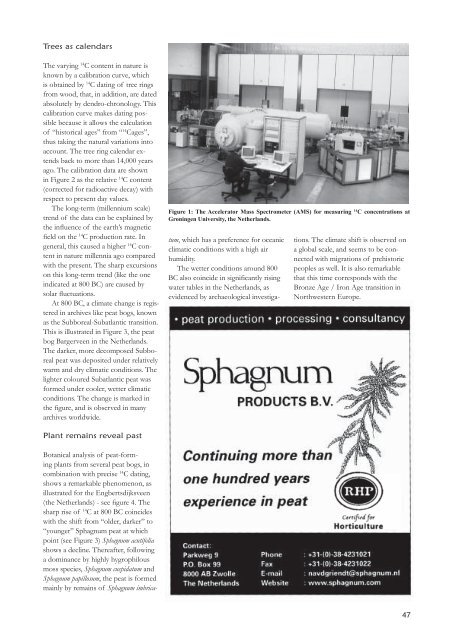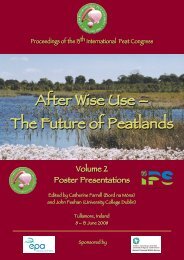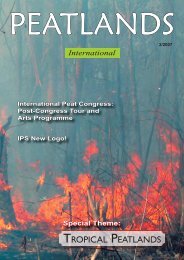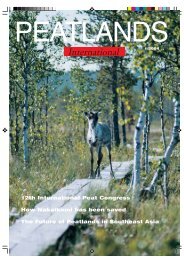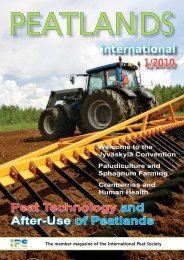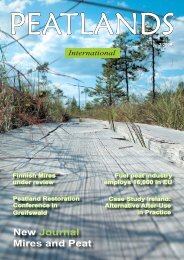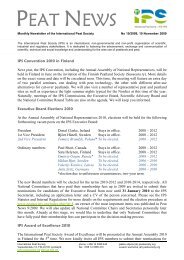peatlands 1 taitto.indd - International Peat Society
peatlands 1 taitto.indd - International Peat Society
peatlands 1 taitto.indd - International Peat Society
Create successful ePaper yourself
Turn your PDF publications into a flip-book with our unique Google optimized e-Paper software.
Trees as calendars<br />
The varying 14 C content in nature is<br />
known by a calibration curve, which<br />
is obtained by 14 C dating of tree rings<br />
from wood, that, in addition, are dated<br />
absolutely by dendro-chronology. This<br />
calibration curve makes dating possible<br />
because it allows the calculation<br />
of “historical ages” from “ 14 Cages”,<br />
thus taking the natural variations into<br />
account. The tree ring calendar extends<br />
back to more than 14,000 years<br />
ago. The calibration data are shown<br />
in Figure 2 as the relative 14 C content<br />
(corrected for radioactive decay) with<br />
respect to present day values.<br />
The long-term (millennium scale)<br />
trend of the data can be explained by<br />
the infl uence of the earth’s magnetic<br />
fi eld on the 14 C production rate. In<br />
general, this caused a higher 14 C content<br />
in nature millennia ago compared<br />
with the present. The sharp excursions<br />
on this long-term trend (like the one<br />
indicated at 800 BC) are caused by<br />
solar fl uctuations.<br />
At 800 BC, a climate change is registered<br />
in archives like peat bogs, known<br />
as the Subboreal-Subatlantic transition.<br />
This is illustrated in Figure 3, the peat<br />
bog Bargerveen in the Netherlands.<br />
The darker, more decomposed Subboreal<br />
peat was deposited under relatively<br />
warm and dry climatic conditions. The<br />
lighter coloured Subatlantic peat was<br />
formed under cooler, wetter climatic<br />
conditions. The change is marked in<br />
the fi gure, and is observed in many<br />
archives worldwide.<br />
Plant remains reveal past<br />
Botanical analysis of peat-forming<br />
plants from several peat bogs, in<br />
combination with precise 14 C dating,<br />
shows a remarkable phenomenon, as<br />
illustrated for the Engbertsdijksveen<br />
(the Netherlands) - see fi gure 4. The<br />
sharp rise of 14 C at 800 BC coincides<br />
with the shift from “older, darker” to<br />
“younger” Sphagnum peat at which<br />
point (see Figure 3) Sphagnum acutifolia<br />
shows a decline. Thereafter, following<br />
a dominance by highly hygrophilous<br />
moss species, Sphagnum cuspidatum and<br />
Sphagnum papillosum, the peat is formed<br />
mainly by remains of Sphagnum imbrica-<br />
Figure 1: The Accelerator Mass Spectrometer (AMS) for measuring 14 C concentrations at<br />
Groningen University, the Netherlands.<br />
tum, which has a preference for oceanic<br />
climatic conditions with a high air<br />
humidity.<br />
The wetter conditions around 800<br />
BC also coincide in signifi cantly rising<br />
water tables in the Netherlands, as<br />
evidenced by archaeological investiga-<br />
tions. The climate shift is observed on<br />
a global scale, and seems to be connected<br />
with migrations of prehistoric<br />
peoples as well. It is also remarkable<br />
that this time corresponds with the<br />
Bronze Age / Iron Age transition in<br />
Northwestern Europe.<br />
47


